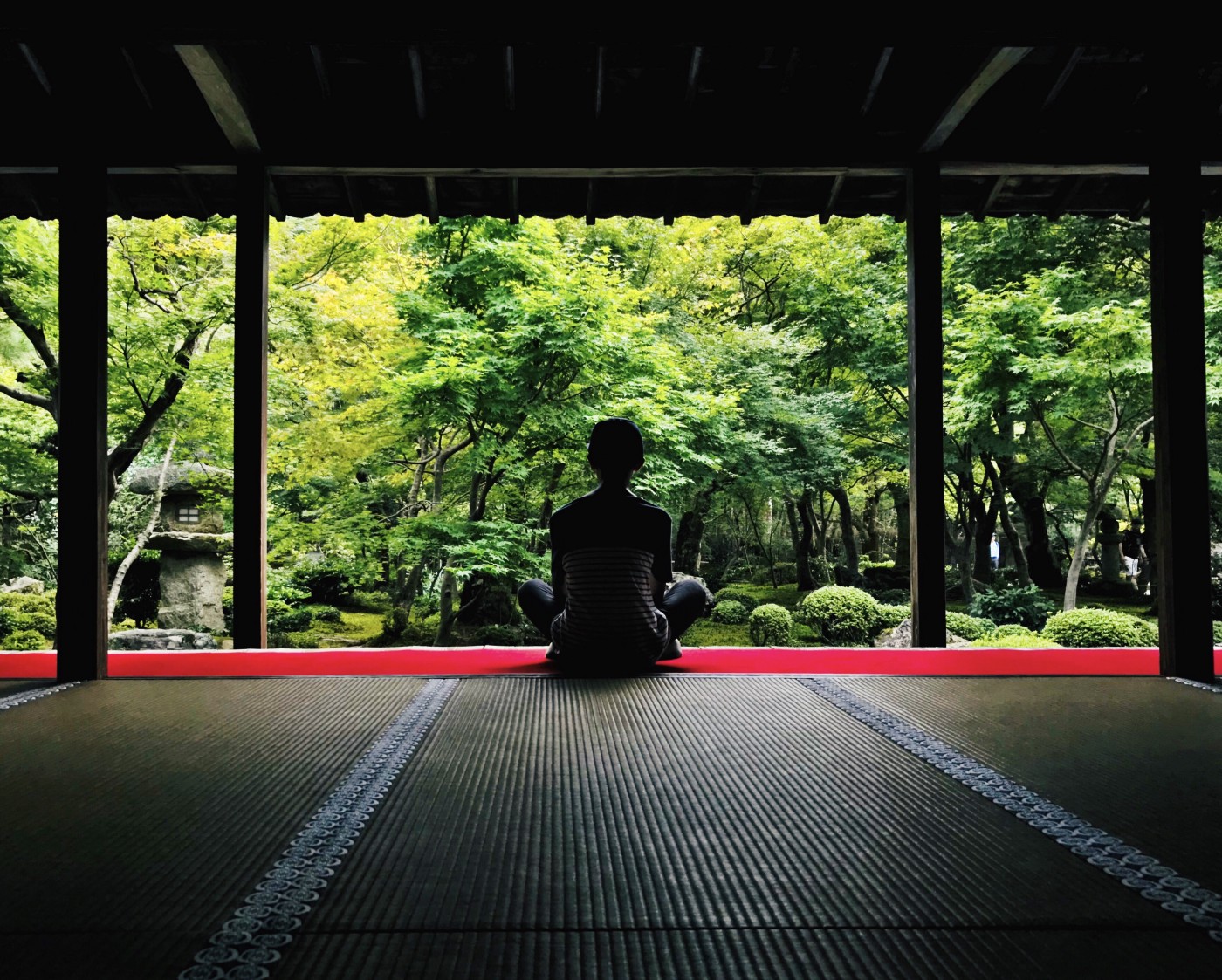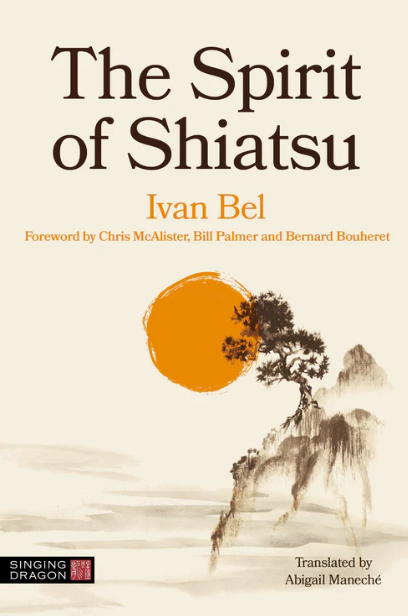Everyone knows about Yin and Yang those twin brothers who are as complementary as they are opposed. One is warmer, the other is denser; the former is lighter, the latter is deeper. While we are usually familiar with these comparisons of quality, we are less familiar with their system relationship. What is the relation between depth and appearance, exterior and interior? The concept of Omote-Ura lets us better explore this dynamic. We shall see together what this reality is, using linguistic, cultural and medical tools. We shall travel through China, Korea and Japan.
Every language is a tool for sculpting a reality different from its neighbour. By studying, translating and assimilating the terms produced by another culture, we can look at the world with a new set of glasses. By viewing the world differently, we discover new aspects of it. Of course, the Japanese language is no exception.
Here we are going to look at a fundamental couple of Japanese thought which is also found in traditional Chinese medicine. This is the omote-ura pair, which some people know better by its Chinese name: biao-li「表裏」. Since the characters are the same, we will refer in turn to omote-ura, as understood in Japanese culture, and then to biao-li, as described in the classics of Chinese medical literature.
But first, let us look at the meaning of the characters.
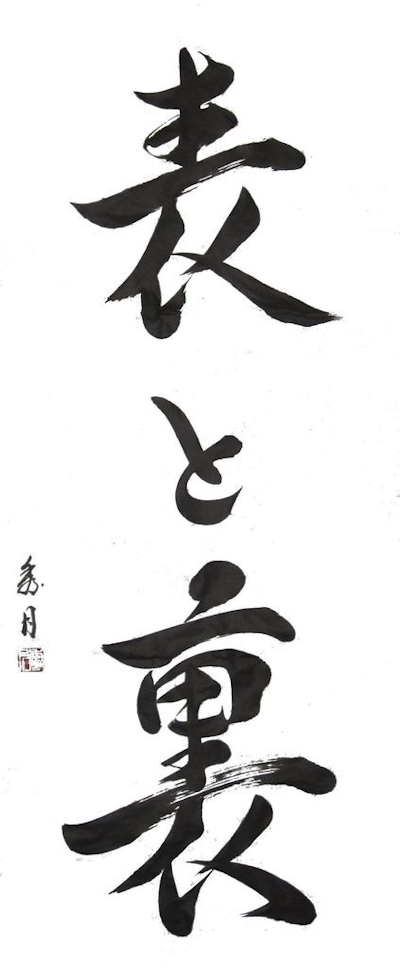
Etymology of 「表」
Readings:
- Japanese : omote, arawa.su, hyō
- Chinese : biao
Key Point:
The top key is a transformation of the character for hair「毛」.
The key underneath is 「衣 koromo: garment, clothing.
Indeed, Ancient Times fur garments (kawagine皮衣) had hair showing on the outside.
Meaning: This character indicates the appearance, the surface of something, which is why it is the key to garment「衣. Like a garment, this character has the meaning of showing, displaying, presenting something. It is therefore found in a wide variety of terms such as a “representative of an assembly” (daihyô 代表), a “spoken expression” (hyôgen 表現) or a “billboard” (hyôshi 表示). Indeed, whatever one chooses to present must be visible.
Apparent by its function, either hair on the outside is to insulate the leather or it is made to be visible in order to convey a message.
We can therefore retain that biao/omote designates everything that is visible and refers to the domain of appearance and external manifestation. Something that can be easily observed.
Etymology of 「裏」
- Japanese : ura, ri
- Chinese : li
Meaning: We find the key for garments again. This time we must understand garment in terms of the part which is close to us, in its interiority. It is the hidden and precious pattern of the garment that we reserve for the outside world. Combined with its antonym, it can be translated as the pairs Observe-Reverse, Heads-Tails or Recto-Verso. This pair expresses the two aspects of the same element, of the same reality, a famous four-character formula (yojikugo) illustrates this well: Hyô ri i ttai「表裏一体」
Literally obverse-reverse: the same body. This expression could also be translated as: “heads and tails are two sides of the same coin”. A formula to show us that reality has two antagonistic, yet complementary as well as inseparable aspects.
Omote-ura in Far Eastern Asian culture
Omote-Ura has a real life in Japanese culture that is worth explaining. In our mind, it could be the root of a lot of clichés, stereotypes or rosy image that we like to maintain about Japan when we talk about the behavior of its inhabitants or the morals of its society. For instance, what is called the ura no sekkai 「裏の世界」” The under world[OMF2] ” encompasses all the activities of organised gangs such as yakuzas or many other illegal enterprises that are done behind closed doors. This ura no sekai is like a shadow of the ‘civil’ omote society organization.
There are many examples of omote-ura in the Japanese society. We often speak of the Japanese’s diligence at work, but in fact their productivity is not spectacular; for instance, it is lower than that of the French. This is undoubtedly an image sustained by the omote aspect, working overtime is a way of showing (omote) one’s zeal for work. The neat and tidy behavior displayed during office hours can give way to a completely different display during the ‘drinking meetings’ nomikai「飲み会」, on some evenings after work. The hierarchical and polished behaviors therefore have extroverts counterparts where there is no longer any measure: their ura. It is not unusual to see salarymen in suits, leaning on each other until the last metro, or napping on a pavement curb.
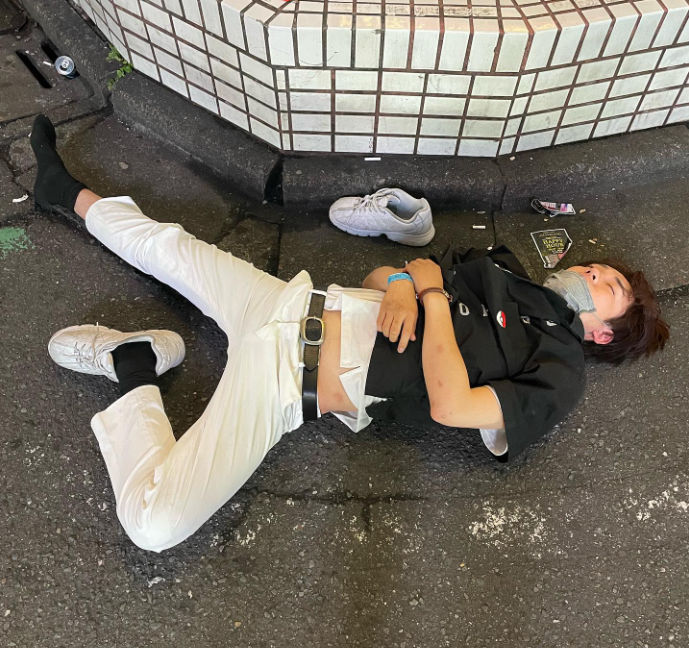
This impetus is not exclusive to Japan, but can be found more widely in the Asian countries of the Far East. For instance, in 2006, the Korean government promised gifts to companies and their employees who would not use the services of an escort during their business dinners or during their end-of-year corporate parties. Whilst the law already prohibits these activities in Korea, this is an omote manner to address an ura facet of reality. It is clear that, despite their apparent contradictions, omote-ura are two dynamics of a single reality.
On the individual and social scale, to borrow a term from the Jungian psychology, we could say that the relation between omote-ura is similar to the relation between the Self and its Shadow. The Self is based on a mask (persona) to represent and express itself; it is an external and superficial appearance that conforms to norms and conventions. The Shadow lurks behind the mask and at times bursts forth in outpourings that may seem at odds with the omote aspect. The consciousness and the unconsciousness, the rational and the emotional, the order and the chaos, that which one chooses to manifest and that which one chooses to keep to oneself are in fact part of the same body: the human being.
Now let us see how the Yin-Yang dialectic of Chinese Medicine enables us to understand these interactions.
Biao-li in Chinese medicine
Biao – Li [1] is one of the fundamental pairings of great importance for many reasons.
It enables the therapist to establish a therapeutic relationship with the patient, to conduct a diagnosis and especially to know how to implement the treatment.
To begin with, Biao-Li is one of the four pairs that constitute the “Eight Principles” [2] specific to diagnosis. It is the only pair that describes an interaction between two parts of the same system, like the front and back of a coat. The other pairs of the eight principles describe a qualitative (hot-cold) or quantitative (empty-full) appreciation. Obverse and reverse sides communicate through a principle of resonance: in order to respond to each other, they must resonate at the same frequency. This frequency is none other than the complementarity of two movements, the Yin-Yang, which is different for each examined system.
Indeed, the Su Wen tells us in its chapter 25:
“The living man has a body that never escapes the Yin-Yang”.
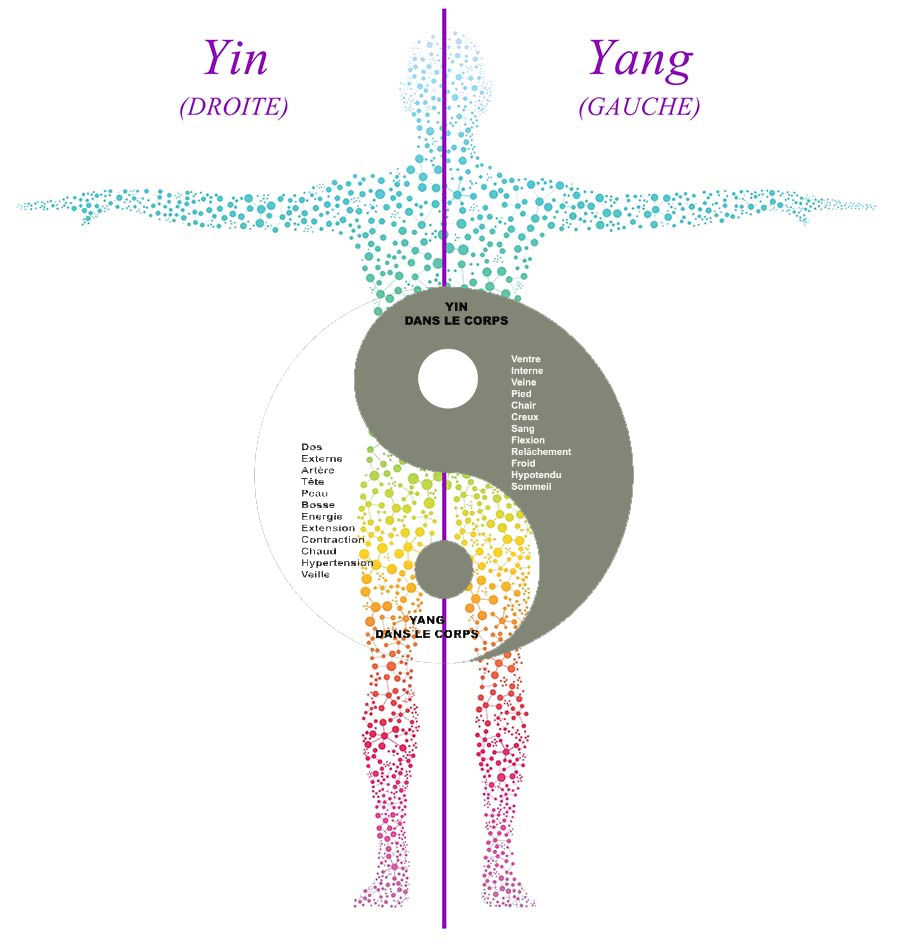
Therefore, in the human body, we will find a multitude of biao-linked relations linked by resonance, much like Russian dolls, intertwined at multiple levels. Undoubtedly the first and most famous of these pairs is the relation “bodily form – breaths”「形気」. At the end of chapter 6 of the Su Wen we read:
“Zhong Zhong, they come and go the Yin-Yang!
They concentrate, they spread,
Carrying out the whole of their circuit:
Blows on the backside (ura)
Bodily form on the obverse (omote),
Fulfilling each other.
The narrative tells us: “It is through a bodily form that blows may concentrate and dwell; but through that concentration of blows, which spread all over from the center, the body enlivens and persists. At the interaction of these two, the mystery of life develops”.
Here Blows are in a reverse position, as they represent all the hidden dynamics of the being, such as the energetic dynamism or, the psycho-emotional sphere. Here, the bodily structure refers to everything related to the manifested body: skin, hair, bodily fluids, muscles and organs… The bodily structure is therefore far more manifested and visible than the blows which animate the interiority of the being.
It should be noted that the blows are also related to the blood in the context of another biao-li pair. We are referring to the ” blood-blow ” pair: ki-ketsu「気血」. In that context, things are reversed: the blows take the obverse position (omote) and the blood takes the reverse (ura). Indeed, the blows cause the blood flow and from the blood come the different blows. In this context, we can say that the blood is the “hidden face” of the blows, its ura.
As in the case of Yin-Yang, we can clearly see that these pairs are only defined in relation to one another. There is nothing that is intrinsically Yin or Yang, in much the same way that there is nothing that is fundamentally omote or ura. They must be understood in relation to one another. This is known as the ‘relational identity’.
There are numerous examples of omote-ura in the body; for instance, we can distinguish 5 major levels in the bodily and energetic structure, where obverse-reverse pairs respond to each other (here from the surface to the inside).
1. In the body structure
- Skin & hair, muscles and superficial circulation are the obverse of the body
- Organs (zang), bones and marrow are the reverse.
2. In the main meridians
- The 3 Yangs are obverse
- The 3 Yins are reverse
3. In the Yangs
- Taiyang is obverse
- Yangming is reverse
4. In the Yins
- Taiyin is obverse
- Shaoyin is reverse
5. In a system (e.g. the digestive system)
- The viscera is obverse (ex: Stomach)
- The organ is reverse (ex: Spleen)
Knowing the interactions between these different pairs, the practitioner can clearly observe and distinguish what is in front of him:
“Through the manifestations (omote), he reaches the structures (ura);
By the mere observation of the appearance presented by
The overcoming (fullness) and the non-reaching (emptiness),
He perceives the subtle and detects what is wrong;
His art is never in default. (SW5)
One thing remains necessary for such an observation: the attitude and posture of the practitioner. From where does one observe? The inner and the outer posture are fundamental to form a truly “therapeutic relationship”. Indeed, we do not treat symptoms or illnesses, but we accompany other human beings to feel “vibrant” with peace and joy in their relationships with themselves, their loved ones and their surroundings. Only when the resonance between their inner and outer worlds (their own omote-ura) is reestablished can the so-called “illness” disappear. In order for this to happen, the first of the therapeutic resonances must take place: the one that occurs in the practice room between therapist and patient, between donor and receiver, between Heaven and Earth. Thus, it is through his inner knowledge, through the knowledge of his own ura side, that the practitioner connects to the patient’s ura, to his part of shadow. When omote and ura interact, then the therapeutic alliance is formed.
Chapter 6 of the Su Wen already taught us this more than two millennia ago:
“From what is of him, he (the practitioner) reaches the other.” (SW6).
This is reminiscent of the quote of Akinobu Kishi, the founder of Seiki: “In the resonance, I do not know whether it is the patient who treats me or I who treat the patient”. (p.136)
Both together and apart, universal and particular are the two aspects of Life which communicate and respond to one another.
Or more simply, as the Thai say: “same same but different”.
May this article enable us to resonate with ourselves, our patients and the universe, in order to regain unity in its dual aspect.
Notes:
[1] Since we are now within the framework of the vocabulary specific to Chinese medicine, we have chosen to designate them as they were in the texts, i.e. in Chinese rather than in Japanese. It is strictly the same thing.
[2] As a reminder, these 8 principles are: Yin-Yang, biao-li, hot-cold, empty-full.
Author
- The music of consciousness: 空 the Void in all its forms (part 3) - 29 March 2024
- The Five Elements bowl: 空 the Void in all its forms (part 2) - 20 December 2023
- The space within a character: 空 the Void in all its forms (part 1) - 25 September 2023
- Principle : Omote-Ura「表-裏」 - 3 July 2022
Translator
- Interview with Mitsutoshi Taniguchi - 17 November 2022
